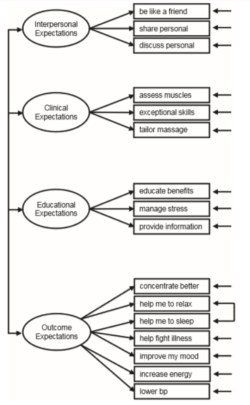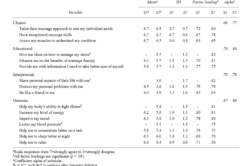
Our research this month was published in the International Journal of Therapeutic Massage * Bodywork Research Education & Practice, September 2012. It comes from the US and from the State of Iowa, where licensed massage therapists must have attended courses at least 600 hours long.
The researchers were interested in developing a way to measure how client expectations of a massage affects the outcomes they experience, seeing as expectations are generally understood to play a key role in outcomes. For them, understanding the expectations might throw light on how massage achieves its benefits. They point out that systematic reviews of medicine show a moderate relationship between what people expect from an intervention and the actual result.
This may be why therapists advise working with clients who want to see improvements. As a reflective point, is this something that you, as a reader, have noticed in a practice between those who are committed to make changes and those who are either not or do not believe it is possible.
Method: The researchers initially engaged with 30 massage therapists and created a focus group of three highly experienced ones. In 2006 and again 2009 they recruited 25 licensed massage therapists who thought they would see at least 20 different clients in a month in Iowa. In sample 1, the clients of 21 therapists completed 367 surveys, of which 356 surveys were eligible). In the second arm of the study the 25 therapists returned 377 surveys, of these 363 surveys from 24 therapists were eligible. The data was collected over five weeks. The researchers thought there were two main aspects to expectations: the role the therapist plays (interpersonal) and the outcome from the treatment (has it achieved something). The client expectations survey was revised between the first and second samples and the researchers used the samples to confirm different aspects of validity.
The surveys included questions on client expectations of massage helping their specific problem, Life Orientation Test Revised (measures positive or negative expectations), Pain scoring pre and post treatment, positive and negative affect measurement (e.g. what mood are they in). Massage therapists also completed a survey as to their demographics, what time of practice they had and their expectations of massage therapy.

Figure 1 Final measurement model for client expectations of massage
The massage therapists who participated in both samples were overwhelmingly female (means of 85.7% and 79.2%), and in their mid 40s (mean ages 47.4/45.9). Some data did vary between the two samples, the second sample had three more years’ experience (the researchers do not state if the two samples overlapped in any way) and were much less likely to be working in a second profession aside from massage.
Techniques offered within the two groups included Swedish Massage, Trigger Point Therapy, Stretching, Neuromuscular Therapy, Reflexology, Reiki/Therapeutic Touch and Cranio Sacral Therapy. Aromatherapy was included within the list of practice along with: encouraging increased water intake, stress management, stretching for homework, heat application, exercise counselling and ice/cold application.
The client expectations scale for the two samples (S1 and S2) is shown below. They break down in the four aspects of clinical expectations, educational expectations, interpersonal outcomes and general outcome. Clients has a scale of 1 to 7 where 7 was a strong agreement and 1 a strong disagreement with the statement.

The most significant results pre and post treatment were for pain reductions, serenity and negativity (negative affect). These positive changes in serenity were predicted by higher outcome expectations.
One of the clearest interrupters to a feeling of serenity was a correlation between an expectation of interpersonal. The researchers point out “the more a client expected their massage therapist to share personal aspects of their life, be friendly, and discuss clients’ personal problems, the less improvement in serenity they reported after the massage”. Seeing that both samples strongly agreed that they wanted the treatment to help them sleep at night and help them to relax, this is a key learning.
This research would suggest that clients with higher expectations will have better outcomes, unless their expectations include a social interchange. It is also a reminder that therapists who share details of their own lives may not be best aiding their clients to relax or improve a range of outcomes.
The full article can be downloaded here